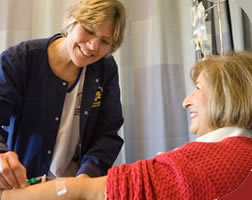Finding Hope in Science
Phase 1 clinical trials offer options when standard treatment isn't a choice

A little more than eight years ago, Diana Tarnacki was diagnosed with ocular melanoma. It hadn't spread beyond the eye, so she opted for plaque radiotherapy, a unique type of radiation therapy for people with eye tumors. Specialists at the University of Michigan Kellog Eye Center attached a thin piece of metal lined with radioactive seeds to the wall of her eye. The procedure destroyed the tumor.
But her doctors warned her that the melanoma could come back. And in April, it did. Scans showed the melanoma had spread to her bones and possibly her liver and lungs as well. Her oncologist explained that she had run out of standard treatment options. But she might qualify for a study that would give her access to the latest potential therapies for cancer. She talked it over with her husband, Bill, who was as anxious as Diana to find another possibility for treatment. Diana accepted the offer.
"It's difficult to hear that there's nothing more they can do, so you look for something you can do anyway," she said. "This study sounded like something that had potential. And I didn't want to be sorry that I didn't try what I could try to fight it."
The University of Michigan Rogel Cancer Center recently launched a new initiative to speed promising therapies from the laboratory to the clinic -- where all patients may eventually benefit. In the meantime, however, part of the core mission of the newly established Ravitz Foundation Phase I/Translational Research Center is to offer new opportunities to patients who have no other options.
Phase I clinical trials are the first step in testing a potential new therapy in people. They focus on determining the right dose and method for delivering a drug. The ultimate question Phase I trials seek to answer is: Can this new drug slow down or stop cancer growth in a dose patients can tolerate?
Patients are monitored very closely to ensure their safety. As cancer research has evolved, drugs have become much less toxic, lowering patients' risk significantly, said Moshe Talpaz, M.D., associate director of translational research at the U-M Rogel Cancer Center.
"Traditionally, when we looked at chemotherapy, we looked at how much we could give a person, assuming that more is better. We know now from Gleevec and other drugs that more is not always better. Now we're looking for the optimal biologic dose and the biological changes associated with response," he said. "It probably provides a better chance of benefit than in the past because we have become more systematic in our research."

A Targeted Approach
Tarnacki began participating in a Phase I trial in August. She continues to receive a drug that researchers hope will target cancer cells specifically. This approach to cancer treatment -- called targeted therapy -- differs from systemic therapies, like chemotherapy. Typically, chemotherapy drugs kill rapidly dividing cells-regardless of whether they're cancer.
The trial runs in eight-week increments; after the first eight weeks were finished, Tarnacki signed up for another round. Scans show no change in her cancer.
"This means a lot to my husband and my family and obviously to me," said Tarnacki, who served as director of religious education for her church before retiring. "To have a strand of hope is very, very important. I never realized how important it is. I can know the facts, but that blind hope is very important."
The Ravitz Center is unique in that it focuses solely on targeted therapies. In this approach to cancer treatment, researchers try to develop medications that interrupt the signals that cause cancer cells to reproduce.
Because targeted therapies are focused on cancer cells specifically, they tend to cause fewer side effects. Tarnacki said she has experienced only minor side effects related to changes in her blood sugar levels.
"Unfortunately, there are diseases like Diana's where there are no standard treatments," said David Smith, M.D., clinical director of the Ravitz Center. "One of the things we can offer in that situation is a clinical trial of a promising targeted therapy. These studies don't come with the typical side effects of standard chemotherapy -- which even though that's a more common therapy, is really a long shot for patients like Diana."
Conquering Cancer Through Innovation
Ultimately, the goal of the Ravitz Center is to bridge the gap between the laboratory and the clinic. In Phase I trials, patients with several types of cancer may participate in a single study. Once researchers determine the best dosage of a drug, they will use what they learn to help develop broader studies.
Phase II and III trials -- which study a therapy's effectiveness and involve larger numbers of patients -- are already conducted throughout the Rogel Cancer Center. The core difference is that the Ravitz Center will help to bring some of the most promising ideas from Cancer Center labs into the clinics.
The Rogel Cancer Center is a leader in the field of cancer stem cell research. Cancer stem cells are the small number of cells within a tumor that are capable of fueling the tumor's growth. These cells generally represent fewer than 5 percent of all cells in a tumor, but they are believed to be the cells that cause cancer to grow and spread.
Researchers believe more effective cancer treatments could be developed by finding ways to target and kill cancer stem cells. Eventually, these concepts may be tested in Phase I trials at the Ravitz Center, Talpaz said.
Regardless of which ideas the Ravitz Center is exploring through clinical trials, its doctors and staff always put patients and families first.
"We have new ways to provide our patients with access to cutting-edge treatments that we haven't had before," Smith said. "But ultimately, our fundamental goal has never changed: We're here to take care of people. This gives us one more way to do that."
To find out if you may be a potential candidate for a trial, talk with your physician.
Read the Winter, 2009 issue of Thrive.
